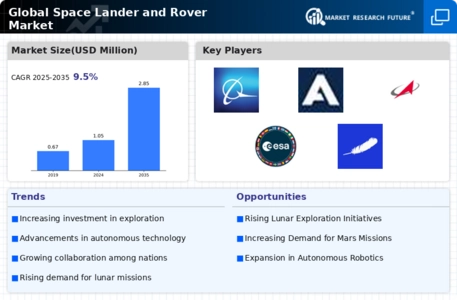Market Trends
Key Emerging Trends in the Space Lander Rover Market
The market for space landers and rovers is exhibiting dynamic patterns that correspond with the growing exploration and exploitation of space outside of Earth. Sophisticated lander and rover solutions are in high demand as space governments and commercial enterprises set out on dedicated projects to investigate the outer planets of the Moon, the red planet, and other celestial bodies. This industry's market trends reflect a convergence of international cooperation, scientific breakthroughs, and a move toward reusable and sustainable space exploration technologies. The emphasis on creating cutting-edge technologies to enable accurate and secure landings on celestial planets is one prominent development within the outer space lander and rover business. The increasing frequency of exploration of the solar system missions has led to a greater need for sophisticated landing technologies that can navigate difficult terrain. To guarantee an effective placement of landers along with rovers on alien surfaces, the current development includes the integration of self-navigating capabilities, hazard prevention systems, and precise landing technologies. The market for space landers and rovers is now heavily influenced by international cooperation, as space agencies from various nations combine their resources and knowledge to carry out challenging exploratory missions. The establishment of uniform interfaces and guidelines, exchange of information, and cost sharing are all facilitated by working together. International collaborations also make it easier for scientists to share data and discoveries, encouraging a team method for space research and optimizing the potential of rovers and landers. Reusability and sustainability have grown in importance in the astronomical exploration sector, impacting space lander & rover market dynamics. In order to lower total mission costs and impact on the environment, businesses and space organizations are investigating ways to create landers and rovers which might be reused for numerous trips. This trend emphasizes the significance of optimizing the usability of space assets and is consistent with the industry's larger movement towards environmentally friendly procedures in space exploration. Propulsion systems used by space landers along with rovers are being developed with an eye toward increasing efficiency, energy consumption, and operation duration. In order to increase spacecraft longevity and mobility, improved propulsion technologies, including as electric and ion motion, are being developed. This will enable longer exploration operations and the potential to go to farther locations in our galaxy. Furthermore, how autonomous capacities and artificial intelligence (AI) are combined is influencing the market for space landers and rovers. The effectiveness and flexibility of landers along with rovers into constantly changing and unpredictable alien environments are improved by AI-powered systems that enable navigation on their own, avoidance of obstacles, and decision-making processes. This pattern shows how dedicated the industry is to using state-of-the-art technologies to optimize scientific mission output while overcoming space exploration hurdles. Another noteworthy advancement for the business is the commercialization of space-related operations. Private businesses are becoming more and more important in coming up with creative solutions for exploring outer space, such as creating and managing rovers and landers. The transition to commercial space exploration adds to the overall expansion and variety within the space exploration environment by introducing competition, encouraging innovation, and expanding opportunities for both private and public organizations to work together. In conclusion, technological developments, global partnerships, sustainability concerns, propulsion breakthroughs, and the incorporation of artificial intelligence are all driving significant changes in the space lander & rover sector. The trends in this industry show a concerted effort to push the limits of space exploration, open new frontiers, and deepen our knowledge of cosmic phenomena as humankind strives to investigate the cosmos. The dynamic field of space rovers and landers offers stimulating prospects for new scientific findings and improvements in space exploration technologies in the future.









Leave a Comment